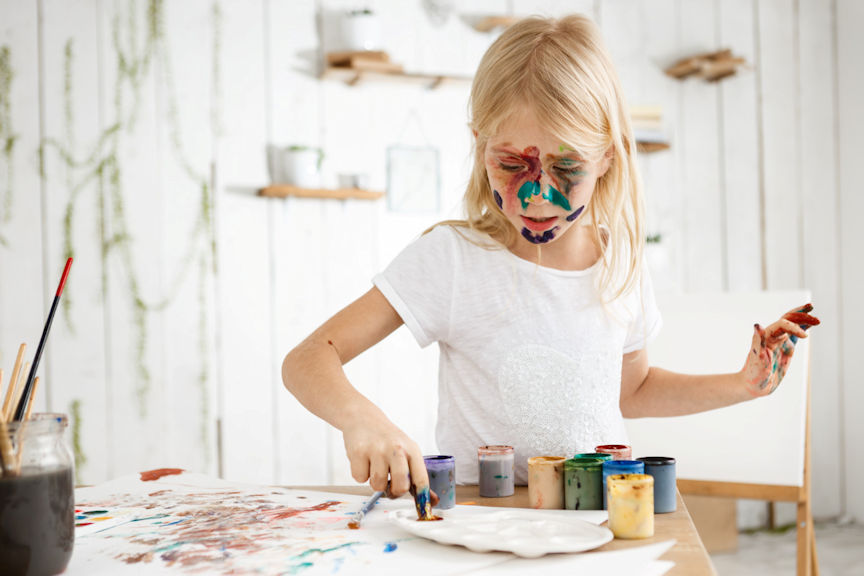Artistic expression offers a powerful outlet for children – especially those with learning disabilities. After all, art allows children to communicate thoughts and emotions in a way that transcends traditional language barriers. Artistic creations can also be incredibly liberating for those who face challenges in conventional learning environments. In this guide from Funtastic Learning Toys, you’ll discover how to cultivate a nurturing space for your child to explore their creativity through art.
Tailoring Art to Fit Each Child
Understanding your child’s specific learning disability is crucial to providing appropriate support. Each disability impacts learning and expression differently, requiring a tailored approach to foster effective communication through art. You might need to modify techniques or provide alternate forms of instruction based on your child’s needs. Ensuring that the artistic process is adapted to their learning style can significantly enhance their ability to express themselves.
Exploring Diverse Artistic Tools
Art supplies can spark creativity and cater to sensory needs and motor skills. Offer your child an array of materials like paints, crayons, clay, and even digital art tools. This diversity keeps the artistic endeavor exciting and helps you identify which mediums resonate best with your child’s abilities and preferences. Having options allows children to experiment and discover their favorite modes of expression.
Come Up with Art-related Businesses
Brainstorming art-related business ideas with your child can be a fun way to inspire their creativity and entrepreneurial spirit. Whether it’s designing custom t-shirts, creating digital artwork for print, or starting a handmade jewelry line, these discussions encourage them to think outside the box. Exploring their interests and talents together helps identify projects they’re passionate about, making it more likely they’ll stay motivated. Plus, it offers an opportunity to teach valuable lessons about planning, budgeting, and marketing in a way that feels engaging and meaningful.
Introducing Music with Toy Musical Instruments
Toy musical instruments designed for special needs learners can offer your child a fun, engaging way to explore their senses while building important skills. These instruments encourage motor development as your child learns to grip, shake, or tap in rhythm. They also promote cognitive growth by fostering creativity, self-expression, and understanding of cause-and-effect relationships. Most importantly, musical play can provide a soothing outlet for your child’s emotions, helping them regulate their feelings in a joyful, supportive environment. Check out Funtastic Learning Toys to learn more!
Accessible Art Tools for Enhanced Interaction
Accessibility can be vital to making art a joy rather than a frustration. Look for tools with larger handles, easy-to-press buttons, or even software that accepts voice commands. These adaptive tools help children with physical disabilities or coordination challenges engage in art-making without unnecessary difficulty. Removing these barriers encourages independence and builds their confidence in their creative abilities.
Enhancing Art with Multisensory Elements
Integrating textures, scents, and sounds into art projects can make the creative process more immersive and enjoyable. These elements cater to various sensory needs and can help maintain interest in a project. For example, adding scented markers, textured papers, or background music can transform the art session into a richer sensory experience that captivates all children.
Creating a Supportive Environment
It’s important to create an atmosphere where experimentation is encouraged and mistakes are seen as part of the learning process. This supportive environment allows children to express themselves freely and without fear of criticism. Encouraging words and focusing on the fun of creation can help build a positive self-image and a willingness to express thoughts and feelings through art.
Focusing on the Artistic Process
Concentrating on the experience of creating art rather than the end product can relieve performance pressure. Enjoying the act of creation teaches children that art’s value lies in the making, not just the outcome. This approach can reduce frustration and make the art-making process enjoyable.
Integrating Personal Interests into Art
When art projects reflect a child’s interests, they feel more engaged and invested in the process. Whether it’s dinosaurs, space, or fairy tales, incorporating these elements into art projects can make the experience more enjoyable and relevant. This personalized approach heightens motivation and makes art a meaningful activity that they look forward to.
Through these strategies, you can effectively support your child’s artistic expression, providing them with a fulfilling outlet for creativity that respects their unique learning needs. Understanding their challenges, providing appropriate tools, and fostering a supportive atmosphere as you help unlock their potential for expressive and joyful art-making.
Explore a world of inclusive play with Funtastic Learning Toys, where every child’s joy matters!

